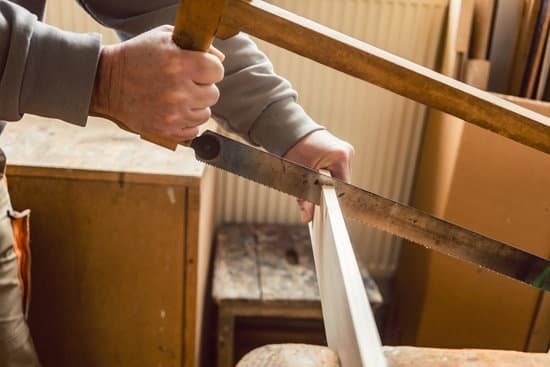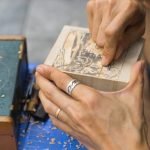Butterfly joint woodworking is a technique that involves the use of decorative and functional wooden inlays to strengthen and beautify joints. Also known as bowtie or Dutchman joints, butterfly joints are not only an excellent way to add strength and stability to woodworking projects but can also serve as stunning design elements.
Historically, butterfly joints were used in Asian joinery as early as the Tang dynasty in China. This innovative technique spread throughout different cultures, with variations appearing in Japanese and Dutch woodworking. Today, they are commonly used in traditional furniture making, fine cabinetry, and artistic woodworking projects.
The primary purpose of butterfly joints is to prevent wood from splitting or cracking due to stress or natural flaws such as knots or grain irregularities. By reinforcing vulnerable areas with these eye-catching wooden inserts, craftsmen are able to make repairs without compromising the overall integrity of the piece.
In this article, we will delve into the fascinating world of butterfly joint woodworking. We will explore the tools and materials needed for this technique, provide a step-by-step guide to creating butterfly joints, and examine the various types of butterfly joints and their applications.
Additionally, we will discuss the strength and stability of these joints compared to other common woodworking techniques, explore ways to enhance aesthetics with butterfly joints, troubleshoot common challenges that may arise during the process, and ultimately inspire readers to master this art form.
So whether you’re a seasoned woodworker looking for new techniques or a beginner eager to explore this unique method, join us on this journey through butterfly joint woodworking. Together, we’ll learn how to create strong and visually striking connections that elevate our woodworking projects to new heights of craftsmanship.
Tools and Materials Needed for Butterfly Joint Woodworking
Essential Tools for Creating Butterfly Joints
To embark on a butterfly joint woodworking project, it is crucial to have the right tools at your disposal. The following are some essential tools you will need:
- Measuring and Marking Tools: Ensure precise measurements by having a combination square, marking gauge, and pencil or knife for accurate marking of the joints.
- Saw: A fine-toothed backsaw or Japanese pull saw is recommended for making clean and precise cuts when shaping the joints.
- Chisel: A sharp chisel is essential for cutting out the waste material within the joint area. It is advisable to have a range of chisels in different sizes to accommodate various joint widths.
- Router: A plunge router with straight bits and guide bushings helps in creating clean and consistent recesses for the butterfly joints.
- Drill: Depending on your project, you may need a drill or drill press to create pilot holes or mortises for further reinforcement of the joint.
- Clamps: Bar clamps, pipe clamps, or specialized butterfly clamps are necessary to hold the workpieces securely during glue-up and clamping stages.
Recommended Materials for Strong and Visually Appealing Joints
Choosing the right materials is crucial not only for their strength but also for achieving visually appealing butterfly joints that enhance the overall aesthetics of your woodworking project.
- Wood Species: Selecting hardwoods such as walnut, oak, mahogany, or maple guarantees durability and longevity of your joints. Ensure that the species chosen has similar expansion and contraction properties to avoid future issues with stability.
- Grain Alignment: Pay attention to grain orientation when selecting wood boards for butterfly joints. Ideally, choose boards with straight grain lines that run parallel to each other as this minimizes any potential weaknesses caused by variations in wood fiber direction.
- Contrast Selection: For an eye-catching effect, consider using contrasting wood species for the butterfly inlays. This creates a bold contrast and visually highlights the joint.
Specialty Tools and Clamps Used in Butterfly Joint Woodworking
While the essential tools listed above are sufficient for creating butterfly joints, there are additional specialty tools and clamps specifically designed to improve accuracy and efficiency in the process.
- Butterfly Joint Templates: These templates help create consistent and symmetrical butterfly shapes by providing guidelines for marking out the joint area accurately.
- Router Templates: Similar to butterfly joint templates, router templates guide the router along a path to ensure precise and consistent recesses for your butterfly joints.
- Specialty Clamps: Butterfly clamps are specifically designed with a dual-screw system that applies equal pressure on both sides of the joint during glue-up, resulting in even clamping and a tight bond.
By having these tools at your disposal, you will be well-prepared to embark on a successful butterfly joint woodworking project.
Step-by-Step Guide to Creating Butterfly Joints
Creating butterfly joints requires a certain level of precision and attention to detail. In this section, we will provide a step-by-step guide on how to create butterfly joints in woodworking projects.
Preparing the Wood: Marking, Cutting, and Shaping the Joints
The first step in creating butterfly joints is to prepare the wood by marking, cutting, and shaping the joints. Begin by determining where the joints will be placed on the wood. It is crucial to mark these areas accurately as it will determine the strength and stability of the joint. Use a pencil or marking knife to create precise markings.
Next, carefully cut along the marked lines using a handsaw or a bandsaw. Make sure to follow your markings closely and make straight cuts. Pay attention to maintaining a consistent depth throughout the cuts.
After making the initial cuts, use a chisel or router to shape the joint space. This step involves removing excess wood from between the cuts to create a recess for the butterfly key or plate. It is important to take your time during this process and make sure that the joint space is clean and well-defined.
Proper Techniques for Chiseling and Routing the Joint Space
Chiseling and routing are essential techniques when creating butterfly joints. To start, use a chisel with an appropriate width that matches the width of your joint space. Begin by removing small amounts of wood at a time until you reach the desired depth. Take care not to remove too much material too quickly, as it can result in weak or loose joints.
Alternatively, you can use a router fitted with a straight bit to remove excess material within the joint space. This method allows for more control over depth and precision. Guide the router along your marked lines while taking small passes until you achieve the correct depth for your butterfly joint.
Remember to frequently check your progress during both chiseling and routing processes. This will help ensure that the joint space is accurately shaped and provides a snug fit for the butterfly key or plate.
Tips for Achieving Precise and Flush Joinery
Achieving precise and flush joinery is crucial when creating butterfly joints for both aesthetic appeal and structural integrity. Here are some tips to help you achieve these desired outcomes:
- Take your time: Rushing through the process can lead to misalignment or uneven joints. Be patient and meticulous in your work.
- Use sharp tools: Dull tools can result in messy cuts and inaccurate shaping. Keep your chisels, saws, and router bits sharp for clean and precise work.
- Test the fit: Before gluing or securing the butterfly key or plate, test its fit within the joint space. It should fit snugly without gaps or spaces.
- Sand and finish carefully: Once the butterfly joints are in place, sand them flush with the surrounding wood surface. Ensure that there are no rough edges or protrusions. Apply a suitable finish to enhance both the appearance and durability of your project.
By following these steps and tips, you can create beautiful and strong butterfly joints in your woodworking projects. The next section will explore different types of butterfly joints and their applications within woodworking.
Types of Butterfly Joints and Their Applications
Butterfly joints come in various types, each with its own unique characteristics and applications in woodworking projects. The three main types of butterfly joints are key, dovetail, and slip.
Key butterfly joints are named after their shape, which resembles a keyhole. They are typically used to repair cracks or splits in wood by spanning across the damaged area and preventing further spread. Key butterfly joints provide stability and reinforcement to weakened wood structures, making them ideal for repairing tabletops, cabinets, or chairs. This type of joint is relatively easy to create and can add a decorative touch to the finished piece.
Dovetail butterfly joints are widely recognized for their strength and durability. They consist of two diagonal pieces that interlock with each other, resembling a dovetail joint commonly used in cabinetmaking. Dovetail butterfly joints are excellent for joining two pieces of wood together at right angles and providing stability against shearing forces. They are commonly used in furniture construction, such as joining table legs or attaching drawer fronts to sides.
Slip butterfly joints, also known as Dutchman joints or bowtie keys, serve both functional and aesthetic purposes. They are called “slip” joints because they easily slide into place during installation without requiring much force. Slip butterfly joints add visual interest to woodworking projects and can be made from contrasting wood species to create eye-catching accents. While slip butterfly joints do provide some structural reinforcement, they are most commonly used for decorative purposes on tabletops, cutting boards, or picture frames.
| Type | Characteristics | Applications |
|---|---|---|
| Key | – Shape resembles a keyhole
| – Repairing cracks or splits in wood
|
| Dovetail | – Consist of two interlocking diagonal pieces
| – Joining two pieces of wood at right angles
|
| Slip | – Easy to install, slides into place
| – Decorative accents on tabletops, cutting boards, picture frames |
Understanding the different types of butterfly joints allows woodworkers to choose the most suitable joint for their specific project needs. Whether it’s repairing damaged wood, joining pieces at right angles, or simply adding an aesthetic flair, butterfly joints offer versatility and functionality in a variety of woodworking applications.
Strength and Stability of Butterfly Joints
Butterfly joints are not only visually appealing but also offer impressive strength and stability in woodworking projects. Understanding the structural integrity and load-bearing capacity of butterfly joints is essential for ensuring the longevity and durability of your creations.
Compared to other common woodworking joints such as mortise and tenon or dowel joints, butterfly joints provide increased strength due to their unique design. The wings of the butterfly joint extend across the width of the wood, distributing any stress or weight evenly along its length. This makes butterfly joints particularly effective for joining two pieces of wood together, especially when dealing with cracks or splits in the wood.
To further enhance the strength and stability of butterfly joints, reinforcements can be added. One common method is to use epoxy resin to fill in any gaps around the joint, increasing its overall bond strength. Additionally, wooden dowels or screws can be inserted through the joint for added reinforcement.
In terms of load-bearing capacity, butterfly joints are able to support considerable weight when properly executed. The key factor here is ensuring that the joint is precisely cut and shaped so that it creates a tight fit between the two pieces being joined. This requires a high level of precision in marking, cutting, shaping, chiseling, and routing the joint space.
| Strength | Stability |
|---|---|
| Butterfly joints offer increased strength due to their unique design. | The wings of the joint distribute stress evenly along its length. |
| Reinforcements such as epoxy resin or dowels can be added for additional strength. | Precise cutting and shaping ensure a tight fit for optimal stability. |
Enhancing Aesthetics with Butterfly Joints
Butterfly joints not only serve a structural purpose in woodworking projects but also have the ability to enhance the aesthetics of the finished product. By incorporating butterfly joints into your designs, you can create visually interesting and unique pieces that are sure to catch the eye.
One way to enhance the aesthetics of butterfly joints is by selecting contrasting wood species. By using different types of wood with varying colors and grain patterns, you can create a striking visual effect that adds depth and beauty to your project. For example, pairing a light-colored wood like maple with a dark-colored wood like walnut can create a stunning contrast that highlights the butterfly joint.
In addition to contrasting wood species, grain alignment is another factor to consider when enhancing the aesthetics with butterfly joints. Aligning the grain of the butterfly joint with the grain of the surrounding wood can create a seamless and harmonious look. This attention to detail shows craftsmanship and can elevate your woodworking project from ordinary to extraordinary.
Another way to enhance aesthetics is by getting creative with variations and designs incorporating butterfly joints. While traditional butterfly joints usually consist of two halves meeting in the middle, there are countless opportunities for experimentation. You can try different shapes, sizes, and arrangements of butterfly joints to create unique patterns or even incorporate them into intricate inlay designs.
By paying attention to details such as wood selection, grain alignment, and creative design choices, you can truly make your butterfly joints stand out in your woodworking projects. Whether you’re creating furniture, decorative boxes, or other items, adding these beautiful accents will add dimension and personality while showcasing your skill as a woodworker.
Troubleshooting Common Challenges in Butterfly Joint Woodworking
As with any woodworking technique, butterfly joint woodworking can come with its fair share of challenges. In this section, we will explore some common mistakes and pitfalls that woodworkers may encounter when creating butterfly joints and provide tips for avoiding and resolving these issues.
One of the most common challenges in butterfly joint woodworking is achieving a tight and seamless fit between the joint and the surrounding wood. Gaps or misalignment can weaken the joint and compromise its overall strength. To avoid this, it is crucial to ensure precise marking, cutting, and shaping of the joint space on both pieces of wood. Using sharp chisels or routers with a proper technique can help achieve clean cuts that result in tight joinery.
Weak joints can also be an issue when creating butterfly joints. To reinforce the strength of the joints, it is recommended to use hardwood for the butterfly keys themselves. The key should be cut from a piece of wood with a grain alignment perpendicular to that of the main pieces being joined. This arrangement provides stability and adds extra support to prevent any potential weakness in the joint.
In some cases, flaws or mistakes may occur during the creation of butterfly joints. However, these can often be repaired or salvaged with some simple solutions. For example, if there are gaps between the butterfly keys and the surrounding wood, they can be filled using wood filler or epoxy resin that matches the color of the surrounding wood. Sanding and refinishing may also be necessary to achieve a seamless appearance.
By understanding these common challenges in butterfly joint woodworking and implementing proper techniques, woodworkers can overcome potential setbacks and create strong, visually appealing joints. Troubleshooting is an essential part of mastering any woodworking technique, so don’t be discouraged if you encounter difficulties along the way. With practice and patience, you’ll soon become adept at creating beautiful butterfly joints that enhance your woodworking projects.
Conclusion
In conclusion, butterfly joint woodworking is a fascinating technique that adds both strength and beauty to woodworking projects. Throughout this article, we have explored the definition of butterfly joint woodworking, the tools and materials needed, step-by-step instructions for creating butterfly joints, different types of joints and their applications, the strength and stability of butterfly joints, enhancing aesthetics with these joints, and troubleshooting common challenges.
By mastering the art of butterfly joint woodworking, craftsmen can take their projects to a new level. With the ability to create strong and visually appealing joints, they can ensure that their creations will stand the test of time. The historical background of butterfly joint woodworking also adds a sense of tradition and craftsmanship to each piece.
As you delve further into this technique, be sure to continue learning and experimenting with different variations and designs incorporating butterfly joints. The possibilities are truly endless when it comes to creating unique and eye-catching furniture pieces or other items.
If you’re interested in diving deeper into butterfly joint woodworking, there are many resources available online that can provide further learning and inspiration. From video tutorials to forums where you can connect with fellow woodworkers who specialize in this technique, there is no shortage of ways to expand your knowledge in this area.
So embrace the art of butterfly joint woodworking. Whether you’re a seasoned craftsman or just starting out on your woodworking journey, incorporating butterfly joints into your projects will elevate your work and showcase your skill as a woodworker. Happy crafting.
Frequently Asked Questions
What is the best wood for a butterfly joint?
The best wood for a butterfly joint is typically a hardwood such as oak, walnut, or maple. These woods are known for their strength and durability, which are essential qualities for creating a strong and lasting joint. Additionally, hardwoods tend to have beautiful grain patterns that can add visual interest to the butterfly joint.
What is a butterfly joint used for?
A butterfly joint is primarily used for reinforcing weakened or split wood. It is a type of woodworking joint that consists of two interlocking pieces in the shape of a butterfly or bowtie.
The purpose of this joint is to provide additional support and prevent further cracking or splitting in the wood. By adding a butterfly joint, it helps distribute stress across a wider area, increasing the overall strength and stability of the piece.
How do you make wood butterfly joints?
To make wood butterfly joints, you will first need to mark out the location and size of the joints on your workpiece. This can be done by using a chisel or marking knife to trace the outline of the desired joint shape onto the wood surface. Next, carefully remove material within this marked area using either hand tools like chisels or power tools like routers. The goal is to create a clean and precise void that matches the shape of your butterfly template.
Once you have completed both halves of the joint on each piece of wood that will be joined together, it’s time to glue them into place using a strong adhesive such as epoxy or carpenter’s glue. Apply pressure with clamps until fully dried and bonded together. Finally, sand any rough edges or excess glue residue before finishing your project as desired for a smooth and professional-looking result.

Hi everyone! I’m a woodworker and blogger, and this is my woodworking blog. In my blog, I share tips and tricks for woodworkers of all skill levels, as well as project ideas that you can try yourself.





